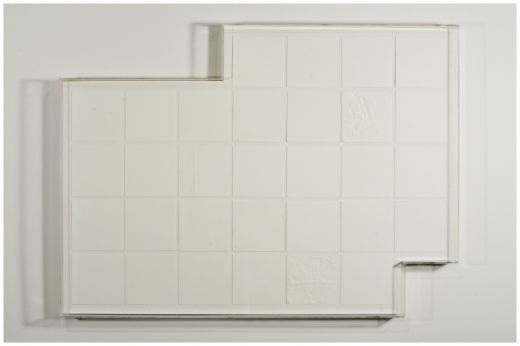Rafael Domenech: Time / Memory / Context
Janet Batet

Rafael Domenech, Untitled (Friedman's strength model of time memory, January), 2014. Surface rubbing on watercolor paper, plexiglass and wood. 23 x 31". Courtesy of the artist and Fredric Snitzer Gallery.
Fredric Snitzer Gallery: October 2-31, 2014
Memory has been at the core of human existence from time immemorial. Our fleeting presence seems to be at the root of a pressing need to seize life through memory and remembrance—the only way, apparently, to defeat time.
Rafael Domenech’s latest exhibition, Time / Memory / Context, deals with the notions of temporality, of sensory perception and spatial relations—concepts that have been at the core of the artist’s research in recent years. Composed of works on paper, in-situ sculptures, and an outdoor installation, this solid show renounces the use of physical images as connectors between memory and the past, favoring instead relational links as the most relevant passage ways between time and memory.
If Domenech’s interest in non-traditional perception mechanisms in his past solo show (Symplectic Structures, NWSA Artseen Gallery, November, 2013) focused on space, now space becomes the analogy to challenge time. Here becomes now, reaching through this conduit out into time and memory. The symbiosis in the middle of these is the foundation of Time / Memory / Context.
“The substance and relationship between these two elements was for me the challenge to tackle, and is chiefly the subject matter of the exhibition,” says Domenech, who further expounds: “from a personal point of view, time-memory is a combination of two words that define existence. Time is the greatest invention of mankind, and memory is the result of the experiences marked through time.”
“Untitled 1-9 (Friedman’s strength model of time memory),” (2014) stands out in this regard. Composed of nine translucent boxes made out of wood and Plexiglas, the work replicates the first nine elapsed months of the current year, January to September. The meticulous grid reproduces the Gregorian calendar and is based on the binary memory model, strength model vs. inference model, proposed by philosopher William J. Friedman. Inside each box are a series of watercolor paper pieces cut to 4” x 4” referring each to the day used to engrave a memory of a particular space.
“Rubbing those squares against texture, be it wall or floor surface,” describes Domenech, “makes the paper capture every found detail, as if with casting material. Rigorously doing one card every day, records were then reviewed the following month, and only those moments remembered were placed back in a previously created holding structure. The small pieces were sited to correspond exactly with the same day of its creation, while the remaining ones were replaced with empty, unmarked paper squares. This existential record created directly refers to the actual source of information, and the relevant value of the moment is its basis.”
With a strong connection to minimal and conceptual art, Domenech’s practice is deeply connected to land art through the importance of process, the selected materials (paper and wood), and the notion of the artifact as reminiscence.
“Untitled (gravity drop),” (2014), is an in-situ sculpture made out of wood slats that, under the pressure of the artist’s body weight, ends up adopting the physiognomy of a drop at its highest tension, drawing a pendant in doing so. The title refers to that moment when the drop reaches maximum size, after which, no longer stable, will only detach itself.
In dialogic relationship with this piece, and sited in the gallery’s outdoor courtyard, “Untitled 1-12 (benches),” 2014, is a relational piece and a poetic interpretation of time as a continuous/discontinuous experience associated with personal knowledge and specific associations. This clean, geometric wood structure can stand as an individual work or as a single continuous one, a strategy that emphasizes the distinct human obsession with parameterizing time. Exposed to the vagaries of weather, the piece is in a continuous process of creation-destruction-recreation, another of the areas of interest intriguing the artist in the recent past.
Time / Memory / Context is the painstaking result of a prolonged one-year investigation on art and perception, in which Domenech methodically probed concepts of absence and presence, memory and oblivion.
Janet Batet is an art historian, art critic, and essayist. Her articles on art practices regularly appear in publications such as Arte al dia, Art Nexus, Art Experience: NYC, Arts on Cuba, and El Nuevo Herald, among others.










